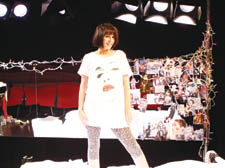|
|
 |
| |

Sadie Frost on stage at the Trafalgar Studios in Touched For The Very First Time wearing an iconic Madonna T-shirt |
Touched by the acting bug – but not for the very first time
Sadie Frost talks to Dan Carrier about
her return to the stage after 20 years
IT has taken Sadie Frost some time to shake off the tabloid shackles that saw her private life discussed in minute detail on a daily basis.
From paparazzi stalking her on the slopes of Primrose Hill to reporters booking tables at Regent’s Park Road restaurants they knew she would be eating in, the actress had become one of those characters whose original reason for being famous had almost been forgotten. Her public image was self-perpetuating, her friends – the likes of model Kate Moss and actress Davinia Taylor – became a “set”, and hacks filled column inches with sordid tales of boozy nights and bed hopping.
And although it’s said that all publicity is good publicity, the actress admits she was so worn down by the constant press attention she decided her career should be in a profession that doesn’t attract quite so much interest.
She battened down the hatches, got on with raising her four children, and threw herself into designing knickers with her business partner Jemima French.
But after a break of 20 years from stage acting, she has now decided to return to the public eye – and what could be more daunting than performing in a one-woman show?
“The producers came to me and asked if I’d be interested,” she says. “At the time, I had no thoughts at all about returning to the stage – I am a mother and a designer now.”
But there was something about the show that attracted her. Written by Zoe Lewis, Touched For The Very First Time tells the story of a young woman who is infatuated with Madonna.
“I come from the generation who was totally blown away by Madonna in our young teens,” she says. “This was an era I knew all about – the 1980s and 1990s party scenes – and it looks into what it meant to be a young woman during this period.”
But it was also a deeper urge to go back to her original work place and see if she could still cut it. It was a shock, she admits.
“When I first looked at the piece and accepted the role, I did not think about how much work it would actually be,” she reveals. “And by the time I did, I panicked. But I had committed myself to it and I couldn’t back out.”
It would also work as a balm to soothe the fact she had been in the newspapers for her private life, not for her acting abilities. She calmly looks back at her time as the queen of the Primrose Hill Set, although at the time it wore her out – her 2004 divorce from Jude Law made front-page headlines around the world. “I was always living in the moment,” she recalls. “There was so much rubbish written about me and I did not feel strong enough to ride it. It was so trivial but it really got to me and I needed to break from this slightly surreal world I had found myself in.”
Playing the lead character requires bravado – she starts off as a 14-year-old and morphs gradually into a 36-year-old. But Sadie says this makes it all worthwhile.
“I am really enjoying it,” she says. “It is amazing to be back in the theatre. I admit though that I do get a little bit lonely as I’m all alone on stage. But this is also quite liberating – I get to try out a whole range of my faces and voices and movements and the character has a good range for me to explore.”
The run, at the Trafalgar Studios in Charing Cross, has reminded her of her first love.
“Of course I am happy working with Jemima at Frost-French, but I was a little frustrated – when you have worked as an actor you have this creative energy that is hard to spend elsewhere,” she reveals.
It has also made her consider the legacy Madonna has left on the generation of women she influenced, in which Sadie includes herself. “It deals with feminist issues,” she says. “But I do not think Madonna is a feminist and what the play says is that Madge gets involved in what suits her character – and career – at the time. Her public image is nothing to do with the liberation of women – she does send out very confusing messages. She made a big thing about being independent but then goes and gets married. She is very contradictory and in the play my character gets confused by this. Eventually she has to say: Who cares? Why take influences from anyone, especially people in the public eye? Just ignore it all and be yourself.”
It appears to be a lesson Sadie has taken in to her life, too.
•
|

|
 |
|
 |
|

